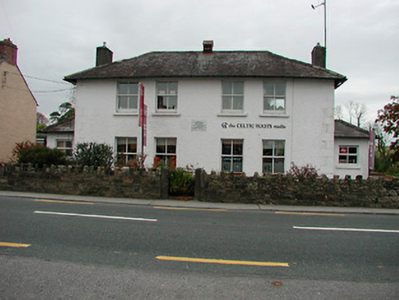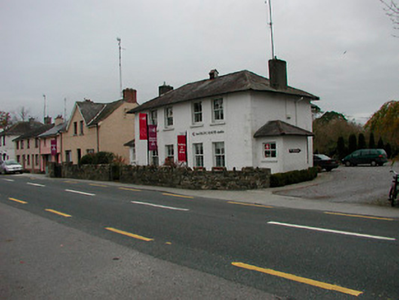Survey Data
Reg No
15403511
Rating
Regional
Categories of Special Interest
Architectural, Social
Previous Name
Ballynahown National School
Original Use
School
In Use As
Shop/retail outlet
Date
1860 - 1870
Coordinates
210181, 233281
Date Recorded
05/11/2004
Date Updated
--/--/--
Description
Detached four-bay two-storey former national school, built 1863 and remodeled in 1924, with flanking single-bay single-storey porches to either side (southeast and northwest) and a two-storey return to rear (northeast). Now in use as retail outlet. Shallow hipped natural slate roof with overhanging eaves, smooth rendered chimneystacks to either end and with a metal air vent to the centre. Roughcast rendered walls with quoins to the corner, now flush with facade. Date plaque with Irish inscription to centre of front façade, above ground floor openings. Square-headed window openings having two-over-two pane timber sliding sash windows to main body of building and modern windows to front faces of porches (southwest), now partially infilled but originally having doors. Set slightly back from road with rubble stone wall to road frontage (south) having crenellated coping over. Gravel yard/carpark to rear (northeast). Located adjacent to the west of the Roman Catholic church (15403512) at Ballynahown.
Appraisal
An appealing and well-proportioned former national school, which retain much of its early character and form. Originally built by John Ennis of Ballynahown Court (15403514) this school is of significance as one of the earliest surviving purpose built educational facilities in the area. The building was remodelled in 1924 and would appear to have changed little over the last 80 years. Since closing its doors to pupils in 1982 the building has found new use as a craft shop. The house adjacent to the school to the west was originally built as a teacher's residence but has been altered over the years. The symmetrical nature of this building, complete with separate entrances for girls and boys, reflects the gender segregation of the early education system in Ireland, particularly during the Victorian period when a great many national schools were constructed in rural Ireland. Located adjacent to both the parish hall and the Roman Catholic church this building occupies an important position within the community and is an integral part of the built heritage of south Westmeath and of the social history of Ballynahown.



